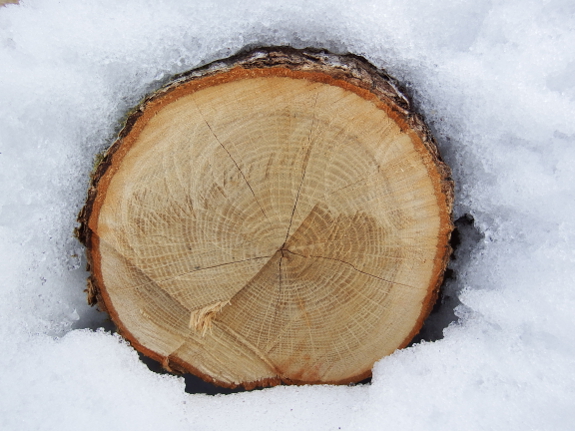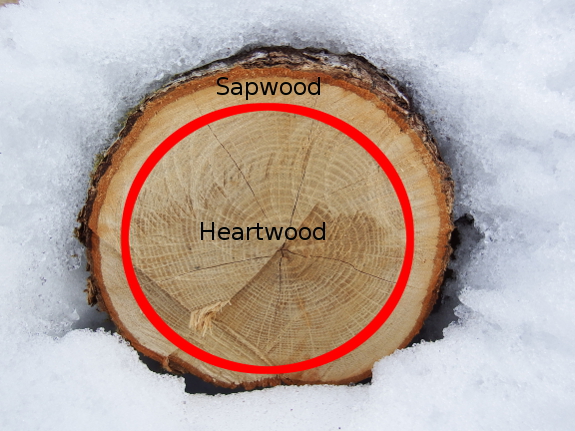
Sapwood in shiitake logs

When I was reading up on
inoculating logs with shiitake mycelium, recommendations on log sizes
varied widely, ranging from 3 to 12 inches in diameter. Large logs tend
to fruit longer and to hold moisture better during dry spells. On the
other hand, small logs fruit faster and are easier to wrangle
(especially if you plan to soak logs to force fruiting).
One factor I didn't read about, but soon thought of once I started looking at the logs Mark cut for me,
is the sapwood-to-heartwood ratio. Shiitakes only eat the sapwood, the
pale-colored wood around the outer perimeter of the log. And bigger
logs, especially if they grew slowly in woodland settings, might have
three quarters of their volume made up of useless heartwood, leaving the
fungi far less food than you might think.

In case you can't pick
out the sapwood in the first photo in this post, here's a labeled
diagram to get you started. This log has been sitting around for a
couple of weeks --- the color difference is even more evident in the wet
wood of a newly cut log.
Looking closely at my
logs got me thinking that maybe the puny 3-inch treetops that I had
earmarked for firewood are actually better mushroom logs than these huge
logs that I'd originally considered prime fungi fodder. In fact, the
smaller-diameter logs have no heartwood at all, so they might contain
nearly as much sapwood as the log pictured above. Assuming I'm willing
to keep logs moist over the summer with sprinklers, perhaps little logs
are the way to go after all?
The decision will have to
be made soon because spring weather is finally upon us! Highs in the
forties and lows in the twenties means it's finally safe to pull the mycelium out of the fridge and inoculate those logs. Time to enjoy the March Into Spring!
Want more in-depth information? Browse through our books.
Or explore more posts by date or by subject.
About us: Anna Hess and Mark Hamilton spent over a decade living self-sufficiently in the mountains of Virginia before moving north to start over from scratch in the foothills of Ohio. They've experimented with permaculture, no-till gardening, trailersteading, home-based microbusinesses and much more, writing about their adventures in both blogs and books.
Want to be notified when new comments are posted on this page? Click on the RSS button after you add a comment to subscribe to the comment feed, or simply check the box beside "email replies to me" while writing your comment.

Wouldn't bigger trees need more sapwood?
Assuming a cilindrical tree piece, the volume of sapwood would be the length of the piece times the surface area of the cross-section. 1/4 of a 12 in tree is a cross-section of 1/4·π/4·12² = 28 in², while the whole cross section of a 3 in tree is only π/4·3² = 7 in². And even is you have a 12 in tree and only the outer inch is sapwood, that would still be π/4·(12² - 11²) = 18 in².
Roland --- I agree --- the big logs do still give you more sapwood. But it seems so wasteful to take the sapwood and ignore the much larger quantity of heartwood that could go in the fire, since you're not wasting anything with the littler logs. (Granted, I never really waste any wood since the rotten mushroom logs eventually turn into organic matter in the garden.)
Amusingly, when I was telling this to Mark, he said that, obviously, we needed to find a way to cut out the heartwood and grow mushrooms so they can pop out on the interior of the mushroom log! That would definitely look cool and would save my "waste" firewood dilemma, but I suspect the tools involved would be way beyond the homestead level.
Not necessarily. If the logs would be short enough to fit upright in a bandsaw, it you could cut off the sapwood relatively easily. Keep in mind that it's perfectly feasable to build your own bandsaw.
And even with simple hand tools you could hollow out a log. It would just take a lot more time.
Both of these technologies have existed for at least hundreds if not thousands of years. Mr Wood not only built his own lathe but also forged his own tools.
On the other hand; would the sapwood need to be in one piece? Could you chop off the sapwood with an axe, giving the fungus a lot more surface area to work with? As I recall you mentioned using bags of sawdust once in a book review.